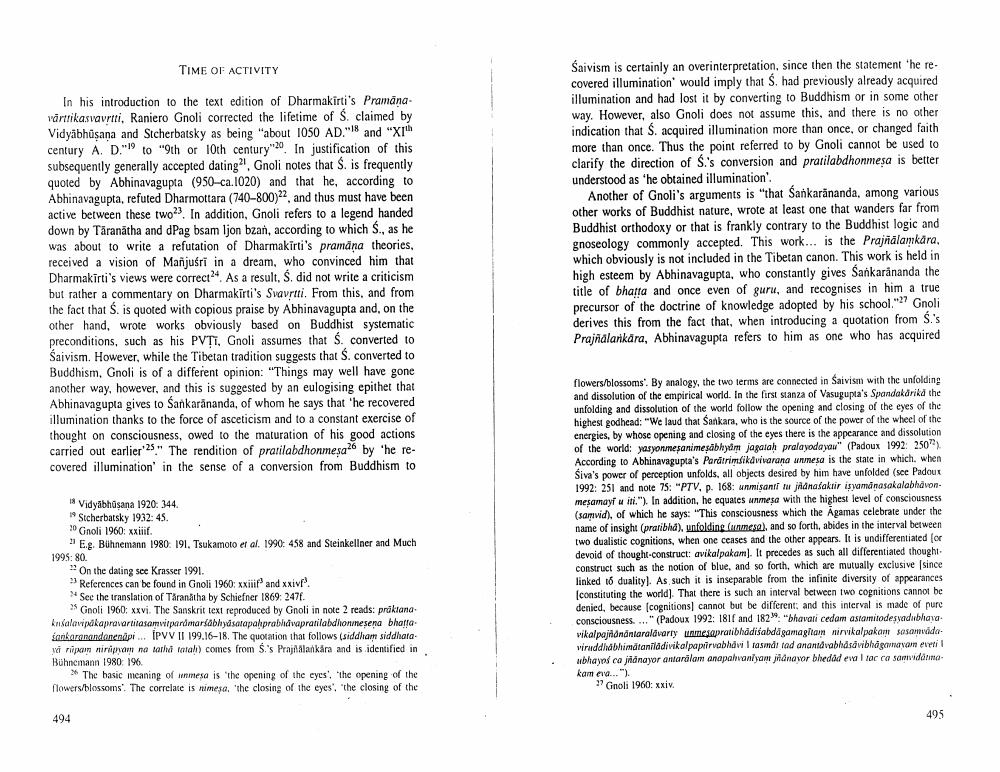Book Title: On Dates And Works Of Sankaranandana Author(s): Helmut Krasser Publisher: Helmut Krasser View full book textPage 4
________________ TIME OF ACTIVITY In his introduction to the text edition of Dharmakirti's Pramāna vārtikasvavrtti, Raniero Gnoli corrected the lifetime of S. claimed by Vidyabhūşana and Stcherbatsky as being about 1050 AD." and "Xh century A. D."" to "9th or 10th century . In justification of this subsequently generally accepted dating. Gnoli notes that $. is frequently quoted by Abhinavagupta (950-ca.1020) and that he, according to Abhinavagupta, refuted Dharmottara (740-800)", and thus must have been active between these two. In addition, Gnoli refers to a legend handed down by Taranātha and dPag bsam ljon bzan, according to which S., as he was about to write a refutation of Dharmakirti's pramana theories, received a vision of Manjusri in a dream, who convinced him that Dharmakirti's views were correct. As a result, S. did not write a criticism but rather a commentary on Dharmakirti's Svavrtti. From this, and from the fact that S. is quoted with copious praise by Abhinavagupta and, on the other hand, wrote works obviously based on Buddhist systematic preconditions, such as his PVTT, Gnoli assumes that s. converted to Saivism. However, while the Tibetan tradition suggests that S. converted to Buddhism, Gnoli is of a different opinion: "Things may well have gone another way, however, and this is suggested by an eulogising epithet that Abhinavagupta gives to Sankarananda, of whom he says that the recovered illumination thanks to the force of asceticism and to a constant exercise of thought on consciousness, owed to the maturation of his good actions carried out earlier." The rendition of pratilabdhon mesa6 by 'he recovered illumination in the sense of a conversion from Buddhism to Saivism is certainly an overinterpretation, since then the statement 'he recovered illumination would imply that S. had previously already acquired illumination and had lost it by converting to Buddhism or in some other way. However, also Gnoli does not assume this, and there is no other indication that S. acquired illumination more than once, or changed faith more than once. Thus the point referred to by Gnoli cannot be used to clarify the direction of Si's conversion and prarilabdhonmesa is better understood as "he obtained illumination Another of Gnoli's arguments is that Sankarananda, among various other works of Buddhist nature, wrote at least one that wanders far from Buddhist orthodoxy or that is frankly contrary to the Buddhist logic and gnoseology commonly accepted. This work... is the Prajndlamkara, which obviously is not included in the Tibetan canon. This work is held in high esteem by Abhinavagupta, who constantly gives Sankarananda the title of bhatta and once even of guru, and recognises in him a true precursor of the doctrine of knowledge adopted by his school." Gnoli derives this from the fact that, when introducing a quotation from Si's Prajndlarikara, Abhinavagupta refers to him as one who has acquired * Vidyābhūşana 1920: 344 Stcherbatsky 1932: 45. ? Gnoli 1960: xxif. "E.g. Bühnemann 1980, 191, Tsukamoto et al. 1990: 458 and Steinkellner and Much 1995: 80. On the dating see Krasser 1991. References can be found in Gnoli 1960: xxiiip and xxiv. See the translation of Taranatha by Schiefner 1869: 247 Gnoli 1960: xxvi. The Sanskrit text reproduced by Gnoli in note 2 reads: prikiana Inšalavidkaprovartilasamvipandmaršablydsafapahprobidvapranilabdhonumesena bharfa sankaranandaneadpi... IPvv II 199.16-18. The quotation that follows (siddham siddhara vei ripam niriman na lari fatah) comes from S.'s Prajalankara and is identified in Bühnemann 1980 19 * The basic meaning of inmesa is the opening of the eyes' the opening of the flowers/blossoms. The correlate is nimesa, 'the closing of the eyes' the closing of the flowers/blossoms. By analogy, the two terms are connected in Saivism with the unfolding and dissolution of the empirical world. In the first stanza of Vasugupta's Spandakärika the unfolding and dissolution of the world follow the opening and closing of the eyes of the highest godhead: "We laud that Sankara, who is the source of the power of the wheel of the cnergies, by whose opening and closing of the eyes there is the appearance and dissolution of the world: yasyonmejanimes blydm jagatah pralayodayaw" (Padoux 1992: 250) According to Abhinavagupta's Pardtrimsikvivarana mesa is the state in which, when Siva's power of perception unfolds, all objects desired by him have unfolded (see Padout 1992: 251 and note 75: "PTV, p. 168: unmisanti tu jildnasaktir isyamanasakalabhavon mesamayi u it."). In addition, he equates unmesa with the highest level of consciousness (samvid), of which he says: "This consciousness which the Agamas celebrate under the name of insight (pratibhd), unfolding (mese), and so forth, abides in the interval between two dualistic cognitions, when one ceases and the other appears. It is undifferentiated for devoid of thought-construct avikalpakam). It precedes as such all differentiated thought construct such as the notion of blue, and so forth, which are mutually exclusive since linked 16 duality). As such it is inseparable from the infinite diversity of appearances constituting the world). That there is such an interval between two cognitions cannot be denied, because Icognitions cannot but be different, and this interval is made of pure consciousness. ..." (Padoux 1992: 1817 and 182" bhavati cedam astamisodesvadbhavavikalpajridnántaralavarty wamesapratibhadisabda gamagitan nirvikalpakan sesamvadaviruddin bhimdtanilddivikalpapirvabhdvil tasandi tad anandabhdadvibhagavam evetil abhayos ca jñanayor antarālam anapahaniyam júnavar bhedad evallacca samvidoma kam eva...). ?? Gnoli 1960: xxiv. 494 495Page Navigation
1 2 3 4 5 6 7 8 9 10 11
